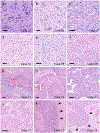High-grade glioma with pleomorphic and pseudopapillary features (HPAP): a proposed type of circumscribed glioma in adults harboring frequent TP53 mutations and recurrent monosomy 13
- PMID: 35103816
- PMCID: PMC9844519
- DOI: 10.1007/s00401-022-02404-9
High-grade glioma with pleomorphic and pseudopapillary features (HPAP): a proposed type of circumscribed glioma in adults harboring frequent TP53 mutations and recurrent monosomy 13
Abstract
Tumors of the central nervous system (CNS) often display a wide morphologic spectrum that has, until recently, been the sole basis for tumor classification. The introduction of the integrated histomolecular diagnostic approach in CNS tumors has facilitated a classification system that is increasingly data-driven and with improved alignment to clinical outcome. Here, we report a previously uncharacterized glioma type (n = 31) using unsupervised clustering analysis of DNA methylation array data from approximately 14,000 CNS tumor samples. Histologic examination revealed circumscribed growth and morphologic similarities to pleomorphic xanthoastrocytoma (PXA), astroblastoma, ependymoma, polymorphous neuroepithelial tumor of the young (PLNTY), and IDH-wildtype glioblastoma (GBM). Median age (46.5 years) was significantly older than other circumscribed gliomas and younger than GBM. Dimensionality reduction with uniform manifold approximation and projection (UMAP) and hierarchical clustering confirmed a methylation signature distinct from known tumor types and methylation classes. DNA sequencing revealed recurrent mutations in TP53 (57%), RB1 (26%), NF1 (26%), and NF2 (14%). BRAF V600E mutations were detected in 3/27 sequenced cases (12%). Copy number analysis showed increased whole chromosome aneuploidy with recurrent loss of chromosome 13 (28/31 cases, 90%). CDKN2A/B deletion (2/31, 6%) and MGMT promoter methylation (1/31, 3%) were notably rare events. Most tumors showed features of a high-grade glioma, yet survival data showed significantly better overall survival compared to GBM (p < 0.0001). In summary, we describe a previously uncharacterized glioma of adults identified by a distinct DNA methylation signature and recurrent loss of chromosome 13.
© 2022. This is a U.S. government work and not under copyright protection in the U.S.; foreign copyright protection may apply.
Conflict of interest statement
Figures





References
-
- Bady P, Sciuscio D, Diserens AC, Bloch J, van den Bent MJ, Marosi C et al. (2012) MGMT methylation analysis of glioblastoma on the Infinium methylation BeadChip identifies two distinct CpG regions associated with gene silencing and outcome, yielding a prediction model for comparisons across datasets, tumor grades, and CIMP-status. Acta Neuropathol 124:547–560. 10.1007/s00401-012-1016-2 - DOI - PMC - PubMed
-
- Boisseau W, Euskirchen P, Mokhtari K, Dehais C, Touat M, Hoang-Xuan K et al. (2019) Molecular profiling reclassifies adult astroblastoma into known and clinically distinct tumor entities with frequent mitogen-activated protein kinase pathway alterations. Oncologist 24:1584–1592. 10.1634/theoncologist.2019-0223 - DOI - PMC - PubMed
MeSH terms
Substances
Grants and funding
LinkOut - more resources
Full Text Sources
Medical
Molecular Biology Databases
Research Materials
Miscellaneous

